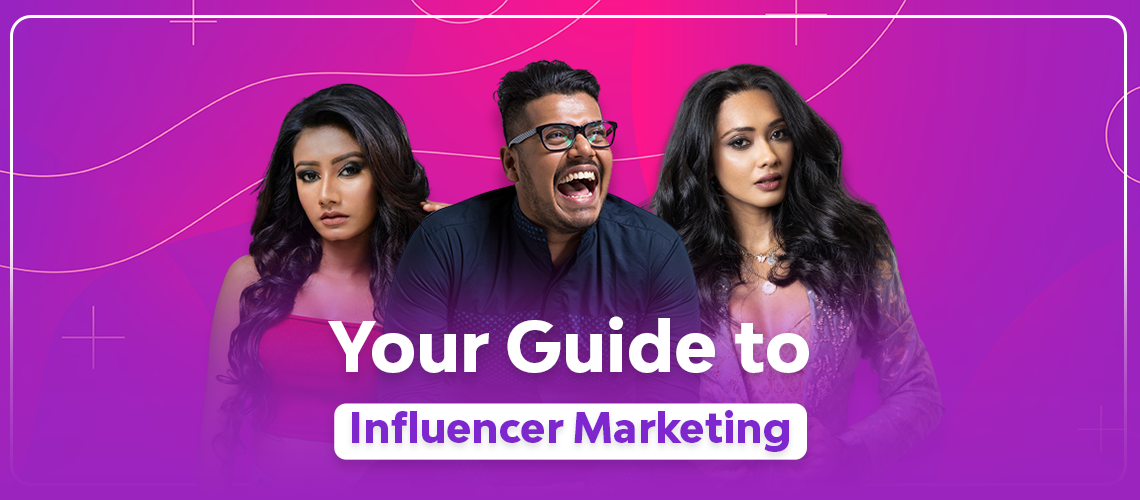With the term ‘influencers’ and ‘influencer marketing’ floating around social media, one begins to wonder what exactly these terms mean and how that knowledge could benefit oneself in the long run. This blog will be your guide to everything you need to know about the subject. So, sit back, read and educate yourself on everything you need to know about influencer marketing.
What is Influencer Marketing?
Influencer marketing is a type of social media marketing that entails endorsements and product placement from influencers, or persons and organizations with a high level of expertise or social impact in their respective fields.
Mark Zuckerberg eloquently described influencer marketing by once saying, “People influence people. Nothing influences people rather than a recommendation form a trusted friend. A trusted referral influences people more than the best broadcast message. A trusted referral is the holy grail of advertising”.
The question then to ask is, who exactly is going to be that trusted referral — the influencer that you listen to? Remember not everyone on social media can be considered an influencer. There is a certain criteria they must meet.
Who is an Influencer?
An influencer is someone who has the power to affect the purchasing decision of someone. They are known for their building a reputation around a particular niche (i.e. – fashion, lifestyle, working out, healthy eating, etc.) and forming a relationship with the audience interested in that subject by creating authentic content which leads to them working with brands to endorse products related to their subject of interest.
Remember, ‘Having influence is not about elevating self but about lifting others – Sheri L Dew.’

Types of Influencers
Influencers usually amass a big following that usually correlates to their topic. However, it is important to note that an influencer is not just someone who has a lot of followers. There are three types of influencers that are categorized below:
- Influencer based on following
- Influencer based on content type
- Influencer based on level of influence
Let’s break these categories down!
- Influencer based on following – These are the influencers who have a huge following across multiple social media platforms. Mega influencers are those who have 1 million + followers such as actress Piyumi Hansamali. Then there are macro-influencers like actress Shalani Tharaka with 100,000 to 1 million followers. Micro-influencers have around 10,000 to 100,000 followers. Musician Ashanthi de Alwis is an example of one. Those with 10,000 followers or less are nano influencers which model and blogger Kalpanee Gunwardana is an example of.
- Influencer based on content type – Influencers are not only those active on social media despite what the majority think. There are bloggers (i.e. – www. Natellabeauty .com, www.letsgoceylon.com) who share blogs on a variety of subjects. YouTubers (i.e.- Ape Amma, Bright Gossip) who create and upload videos onto the video-sharing platform. Podcasters (i.e.- thebadtake.com, techkatha.com) who do live/pre-recordings audios, usually of them talking about a particular topic. Then of course we have the social media influencers (i.e.- @dusky_boii, @zayn_inzi )who actively post across social media platforms such as Facebook, Instagram, Twitter, etc.
- Influencer based on level of influence – This category can be divided into celebrities such as Umaria Sinhawansa (@Umariaofficial), Kavindya Adikari (@Kavindyaadikari), etc. and Key Opinion Leaders that include journalists, academics, industry experts.
How do you identify the right influencers?
When it comes to influencers, how do you know whether they are the right influencer to endorse your product or service and whether they are a genuine influencer not? Anything can be faked on social media, so it is important to be watchful of certain things.
There are three ways you can identify the right influencer. Through a manual search, through a platform/database or through an Influencer Marketing Agency.
- Manual Search – You can do this by using a search engine to find influencers. For example, if you type in ‘your niche + influencers in your location’ in Google, it will provide you with results. Look at ranking tools as they usually show which influencer will garner the most attention to your product. Social media platforms themselves are a great way of searching for influencers because you can see whether any influencers already follow you on social media and get connected or even enable suggestions on Instagram so you can see accounts that have similar tastes to yours.
- Platform / Database – Using a platform/ database is very low-cost and easy to use. They are vast so there is scalability. However, it is important to note that there is very limited choice and little to no assurance of influencer practices. It is quite time intensive as well.
- Influencer Marketing Agency – These have popped up as popularity for using influencers as a marketing tool rose. By using these agencies, you are guaranteed a lasting partnership, their experience and built-in campaign management. However, it is costly and only connects you to digital influencers. Not every agency is the right fit for you.
Influencer Marketing Campaigns
True influence drive actions, not just awareness – Jay Baer
With all this talk about influencers and driving up the publicity of your product, you may be wondering where the evidence for this is. Here are a few well-known influncer marketing campaigns that you might already be aware of.
- The Dettol handwash TikTok Challenge
- The Daraz Mutti Pong Challenge
- Revello campaign
- Microsoft’s ‘Make What’s Next’ campaign
- Watchmaker Daniel Wellingtons’ collaborations with fashion and travel influencers
Benefits of Using Influencer Marketing
Here are some of the benefits of using influencer marketing:
- Quickly builds trust and show authority – As mentioned earlier in the blog, ‘people influence people’, and if you use well-known influencers, customers or your targeted audience are more likely to listen to them as influencers organically build a trustworthy reputation under the public’s eye. Further, your brand can be positioned as the authority in your niche as many consider influencers experts in their area of interest and regard their recommendations highly.
- Improves brand awareness – Influencer marketing has the potential to reach a wider audience, be more engaging, and, ultimately, improving your brand awareness. An influencer has a built-in audience that will in turn create a new audience for your brand driving traffic to your website/socials.
- Effectively reaches your target audience – When you pick the right influencer to promote your product, your target audience will be reached. Once you partner with an influencer that fits your niche, it is likely that their followers could become potential customers interested in your brand, product or service.
- Builds winning partnerships – By collaborating with influencers a long-term relationship can be built and cultivated in order to create a win-win partnership where the brand can continue working with a particular influencer to promote their products/services. This will establish a more authentic relationship between brand and influencer where the audience also won’t be deterred that it is simply a one-time thing.
- Influencers are great for lead generations and drive purchasing decisions – Lead generation is the process of generating consumer interest for a product or service with the goal of turning that interest into a sale. When an influencer speaks, promotes or reviews a product, there will always be a segment of their audience that will be interested and even go on to purchase the product that has been promoted. A great example of this is the strategy undertaken by Spa Ceylon where they had lifestyle/beauty influencers review their products.
- Influencers set trends – They are the trendsetters of this generation. People follow and try their best to mimic an influencer as they put out an image that they have it all together.

Challenges of Using Influencer Marketing
There is always a flip side to things and these are some of the challenges when it comes to influencer marketing:
- Understanding the different types of influencers – As mentioned above, there are different types of influencers out there and not every influencer will be the right fit. For example, if you are an SME, micro-influencers who are aligned with your core values and who share the same aesthetic sense will generate more of an audience to your brand rather than a mega-influencer whose followers are not likely to visit your brand website. However, making that right pick at the right time is a hurdle.
- Finding the best influencer for your brand – There are many influencers out there and finding the best one to promote your brand can usually feel like finding a needle in a haystack (almost impossible).
- Deciding how much control to have over your influencer – An influencer is their own person with their own creative freedom and although they are promoting your brand, they play a big role in how much they promote and say about your product/ service. You cannot dictate what they might say about your brand because if what the influencer says doesn’t feel authentic, the audience will lose trust in both the influencer and you.
- Recording your influencer activity – Influencer activities usually consist of giveaways, contests, sweepstakes, and event activations. However, when it comes to recording all the activity generated from them, it can be hassle as fake accounts and even bots can hamper the campaign.
- Measuring the impact of your influencer marketing – It is hard to keep track of how well an influencer’s post is doing and if you are working with multiple influencers at one time, whose content is generating the most traffic to your brand. Measuring the impact can be quite difficult but there are built-in analytical tools on social media platforms themselves to help.
- Dealing with fake influencers – Anything can be faked on the internet. As of recent, buying fake followers and verifications on social media has created quite the buzz with netizens unsure of who exactly to trust. Beware of fake influencers who pretend to have an organic audience. You can do this usually by seeing their likes and views which will be considerably low compared to their follower count.
However, never fear! We have found a few way that you can address these challenges as well and the first thing you have to do is have a sound and solid understanding about what influencer marketing is and more importantly, what it is not.
Your product/service will not apply to all influencers. You have to tailor your approach to the specific influencer. A slow-fashion influencer is not likely to promote a fast fashion brand as it goes against their beliefs. Don’t simply look at the popularity of the influencer but rather understand your audience and what they would want to be shown. Do your research before committing to an influencer and make sure they match up to you brand’s values and ethos. Check their posts on social media or on their blogs to make sure they have a genuine passion and knowledge in the niche you want them to promote. Having an influencer marketing strategy in place will help immensely.
Diving into influencer marketing can seem daunting at first but it can easily be broken down and understood with a little research and background work. Now, you’ve got the basics down with influencer marketing… So the question left to ask is — are you going to use influencer marketing to promote your brand?
